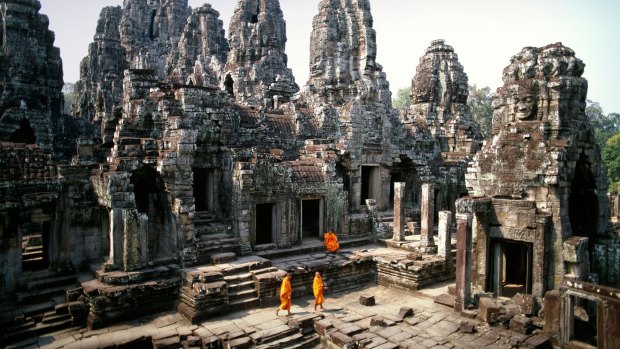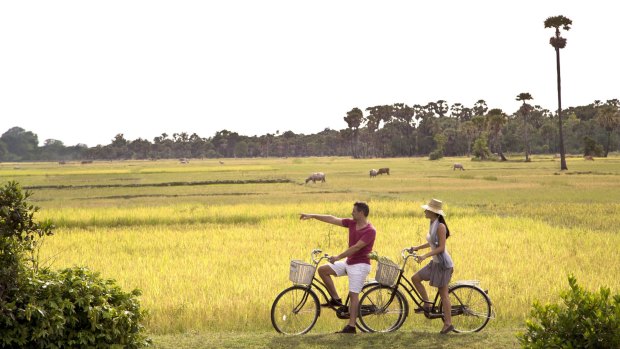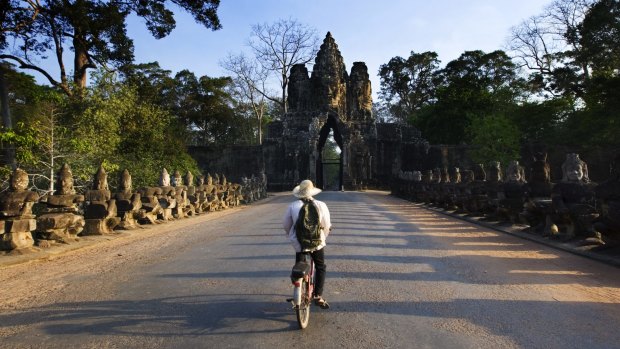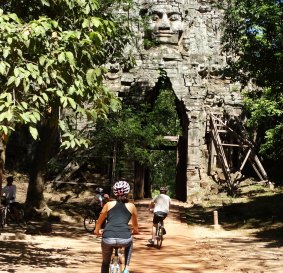This was published 8 years ago
Cycling Angkor Wat, Cambodia: The best way of getting around temples at Siem Reap
By Keith Austin

Bayon temple.Credit: Alamy
IT'S a curious start to the day. Firstly, it's only 8am, the mercury's already nudging a humid 30 degrees and, well, I'm wearing a scarf.
Secondly, what feels like a troupe of Cambodian sampho barrel drummers is banging around my brain thanks to a night at rakish Pub Street, Siem Reap's seething, neon-bright collection of bars, restaurants, nightclubs and "massage" parlours where you can get fish to nibble the dead skin off your feet while getting off your face.
Worse still, the Pub Street evening was two nights ago and the hangover remains. It's that sort of place.

Cycling, Angkor Wat, Cambodia.Credit: Claudio Cerquetti
As for the scarf, it's a traditional Khmer garment called a krama, which is employed by the locals as pretty much anything – scarf, bandanna, shopping bag, sling, sarong, pillow, boxing glove, you name it.
Some sources say the krama has up to 60 different uses and, like the Arab keffiyeh made famous by Yasser Arafat in the '60s, it's certainly practical in hot conditions where it can be used as protection against the sun and as a towel to wipe sweat out of the eyes. It can also staunch a blood flow if you fall off your bicycle.
Now, watching the sun rise over Cambodia's glorious Angkor Wat is, unless you are unduly perverse and have a hankering to visit, say, council flats in south London, on everyone's bucket list. It's up there with Machu Picchu, the Taj Mahal, Easter Island and getting snogged by Kylie Minogue.

Cycling along the road towards South Gate of Angkor Thom.Credit: Getty Images
Of course, by dint of being on said bucket list you will appreciate that you'll be sharing sunrise with several hundred sleep-deprived strangers all straining to take the same awesome photograph, right?
But, you know; it's worth it. Like another UNESCO World Heritage Site, the ancient city of Anuradhapura in Sri Lanka, the vastness, majesty and beauty of the ruins at Angkor really become apparent only when you get there.
Angkor Wat, for instance, is just the one temple; albeit not too shabby on the eye. It is, however, just one part of a sprawling religious complex – said to be the largest in the world – which boasts more than 1000 temples in various states of repair and is more than 800 years old. According to UNESCO the overall Angkor Archaeological Park covers some 400 square kilometres.

Cycling at Angkor Wat, Cambodia.Credit: Keith Austin
And while sunrise at Angkor Wat isn't to be missed it's also nice to get away from the tourist fray and bask in the bosky solitude of lesser-known shrines down little-used trails. There, listening to snatches of birdsong and luxuriating in a warm breeze, you can imagine that you're alone in this most visited of ancient marvels and that that moment belongs to you and you alone.
So, what more perfect way to accomplish that than cycling on this flat, almost featureless plain – faster than walking and enabling you to winkle out corners that coach tours cannot reach.
We are bussed from the hotel to the outer reaches of the park where we rendezvous with the bicycles and head off along shady, tree-lined roads that lead up to the southern gate of the larger, walled "city" of Angkor Thom.
Angkor Thom was established in the late 12th century by King Jayavarman VII, and was the last and greatest capital city of the Khmer kingdom. Estimates put the number of inhabitants in this fabulous jungle city at anywhere from 80,000 to 150,000.
The city covers nine square kilometres, is boxed in by eight-metre high walls which, in turn, are surrounded by a wide, 12-kilometre long moat. It is a perfect square, each side three kilometres long and, in the middle, Jayavarman's piece de resistance, the magnificent temple of Bayon.
We, however, are concerned at the moment with fare less popular but no less impressive. With the southern gate, elephants, souvenir stalls, hawkers and tourist coaches just ahead of us we leave our bikes and find ourselves in front of the overlooked masterpiece of Baksei Chamkrong.
Built in the early 10th century, this four-tiered, 16-metre tall temple, topped by a small sanctuary, sits in a clearing that is, until we arrive, completely ignored by the hordes taking selfies with the face on the southern gate.
From here we head out again, across the bridge, under the gate, before another left turn, this time up a short but steep bank (we get off and walk, mostly) which brings us out on the city wall, looking back the way we've come.
The track is wide enough for several cyclists to ride abreast and we turn away from the gate, heading west with the moat a bright green barrier way below on our left.
Here and there, where sections of old bridges have collapsed, we have to dismount and clamber around forested detours but overall it's an easy ride.
Eventually we negotiate our way down an abrupt slope and find ourselves back on a flat gravel road by another gate, this one less intact and less visited but no less romantic or breathtaking. It's in sections like this, and the archetypal tumbledown temple of Ta Nei that we visited the previous day, that the imagination takes flight.
These, after all, are the remains of a pretty advanced civilisation that was quite literally swallowed up by the jungle for hundreds of years, to become myth. Like El Dorado and Atlantis, the Lost City is the stuff of legend. It's Indiana Jones meets Rider Haggard's Allan Quatermain meets Tomb Raider (filmed here in 2000) meets The Goonies. But unlike those other, fabled, cities, Angkor turned out to be real.
Our next stop is Bayon, the heart of Angkor Thom and, if you ask me, the equal of Angkor Wat in every way. We park our bikes opposite and turn to look at what at first glance seems like yet another tumbling mass of lichen-streaked stone but which, on closer inspection, reveals itself to be remarkable.
In its heyday Bayon consisted of 50 towers, each of which had four enigmatic, smiling stone faces carved into them. Well preserved bas-reliefs outside the temple show boastful images of Khmer military prowess on land and seas while others deal in simple scenes of daily life but it's inside where lies the true majesty.
There are only 37 of the original 54 towers left jutting up from the three terraces that fan out around the central peak but the sight of all those massive stone faces, serenely gazing out over the landscape for eternity is enough to send a shiver up even the most hardened spine.
After Bayon we jump back on the bicycles to visit the Elephant Terrace (lots of elephant statues and carvings, oddly enough) and a small Buddhist shrine before being greeted back at the Anantara minibus with cold water, cold towels and a lift to the Palmboo restaurant where we tuck into traditional Cambodian dishes and replace all that sweat with an Angkor beer or three.
Of course if all that sounds too much like hard work, the Anantara hotel now also runs Vespa tours to the ruins. But isn't that cheating?
There are no direct flights from Australia to Siem Reap but several airlines fly via Saigon, Singapore, Kuala Lumpur and Bangkok, including AirAsia, Vietnam Airlines, Virgin, Emirates and Singapore Airlines.
STAYING THERE
Anantara Angkor Resort is a five-star, boutique hotel with 39 rooms and suites in a grand Khmer-style villa. Deluxe rooms , including breakfast, start at $255 a night (plus tax and service charge); see angkor.anantara.com.
CYCLING THERE
Angkor Archaeological Park passes cost $US20 for one day or $US40 for three days) at the main entrance on the road to Angkor Wat. Always carry your ticket as it will be checked upon each park entry and at major temples. Credit cards are not accepted. The Anantara cycling tour costs $US135.35 (excluding park entry) or you can always be brave and go it alone. It's a very flat and very easy six kilometres from Siem Reap to the Angkor temples.
FURTHER READING
The Angkor Guidebook by Andrew Booth is the perfect companion – full of historic detail without being dense, it's a great guide to visiting the temples and getting the best out of them.
Keith Austin was a guest of Anantara Resorts and Spas.
See also: 20 awesome experiences you need to get up early for
Sign up for the Traveller Deals newsletter
Get exclusive travel deals delivered straight to your inbox. Sign up now.